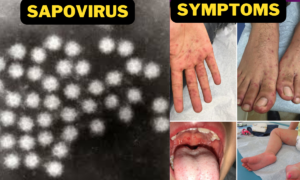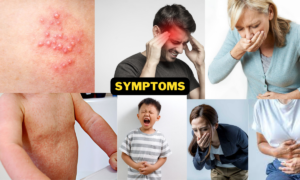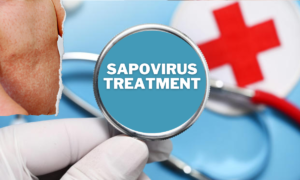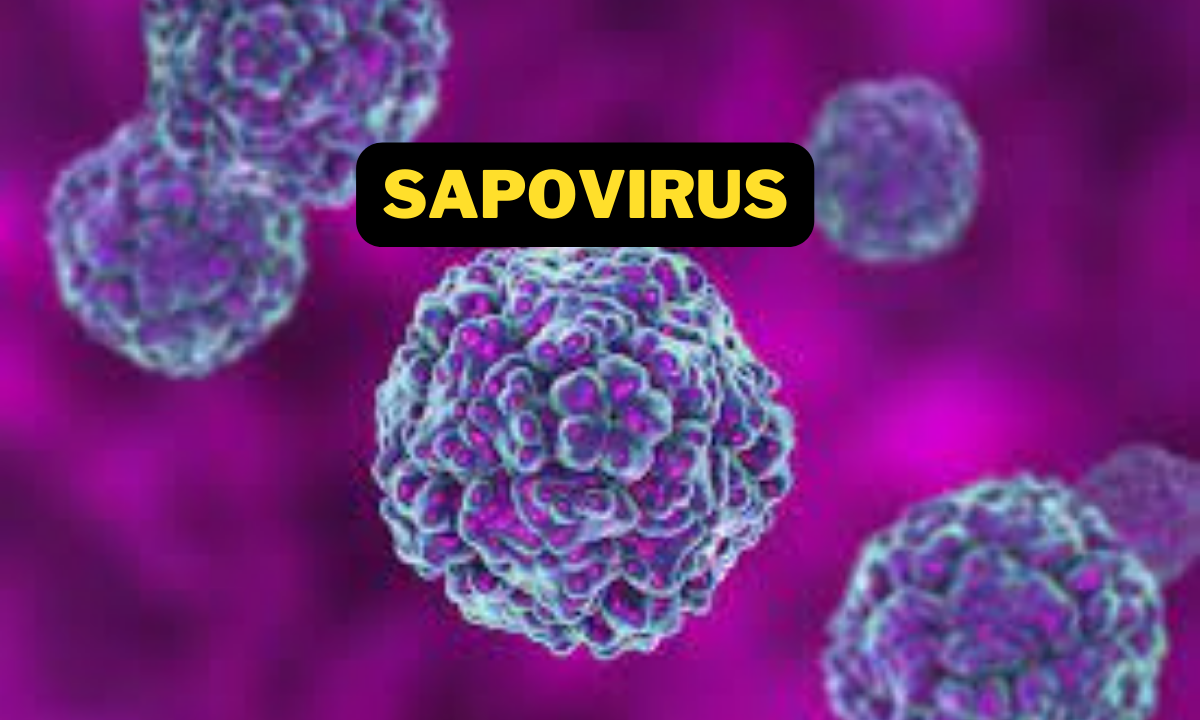What is Sapovirus :Theire Symptoms, Treatment, Causes: सैपोवायरस क्या है उनके लक्षण, उपचार, कारण
Introduction to Sapovirus
Sapovirus, often referred to as sapovirus gastroenteritis, is a type of virus that primarily affects the gastrointestinal tract, leading to symptoms such as vomiting, diarrhea, and abdominal pain. It belongs to the Caliciviridae family and is known to cause outbreaks of gastroenteritis worldwide, particularly in settings such as hospitals, childcare facilities, and cruise ships. Read more…

Understanding Sapovirus: What is it?
Sapovirus is a small, non-enveloped virus with a single-stranded RNA genome. It is classified into several genogroups and genotypes, with multiple strains identified within each genotype. The virus primarily infects the epithelial cells lining the small intestine, leading to inflammation and disruption of normal digestive function.
Symptoms of Sapovirus Infection
The symptoms of Sapovirus infection typically include:
- Nausea

- Vomiting
- Diarrhea
- Abdominal cramps
- Low-grade fever
- Headache
- Muscle aches
In some cases, symptoms may also include fatigue, loss of appetite, and dehydration, especially in young children and older adults.
Causes of Sapovirus Infection
Sapovirus is primarily transmitted through the fecal-oral route, often via contaminated food or water. Person-to-person transmission can also occur through close contact with an infected individual or exposure to contaminated surfaces. Factors such as poor hygiene practices, crowded living conditions, and compromised immune function can increase the risk of infection.

Christina A. Applegate Experiencing “Gross” Sapovirus Symptoms After Inadvertently Consuming Poop. Read more….
Diagnosis of Sapovirus Infection
Diagnosing Sapovirus infection usually involves laboratory tests, including polymerase chain reaction (PCR) assays to detect viral RNA in stool samples. Differential diagnosis may be necessary to distinguish Sapovirus gastroenteritis from other causes of acute gastroenteritis, such as norovirus or rotavirus.
Treatment Options
There is no specific antiviral treatment for Sapovirus infection. Management typically focuses on supportive care, including:
- Fluid replacement to prevent dehydration

- Oral rehydration solutions to restore electrolyte balance
- Antiemetic medications to control nausea and vomiting
- Analgesics to relieve abdominal pain and discomfort
In severe cases, hospitalization may be necessary for intravenous fluid therapy and monitoring of complications.
Preventive Measures
Preventing Sapovirus infection involves practicing good hygiene, including:
- Washing hands frequently with soap and water
- Avoiding close contact with sick individuals
- Cleaning and disinfecting surfaces regularly
- Properly handling and preparing food to prevent contamination
In settings such as healthcare facilities and childcare centers, additional precautions may be necessary to prevent outbreaks, such as isolation of infected individuals and strict adherence to infection control protocols.
Prognosis and Complications
Most cases of Sapovirus gastroenteritis are self-limiting and resolve within a few days without complications. However, in vulnerable populations such as young children, older adults, and individuals with weakened immune systems, complications such as dehydration and electrolyte imbalances can occur. Rarely, severe cases may lead to hospitalization or even death, particularly in individuals with underlying health conditions.
Sapovirus in Children

Children, especially infants and toddlers, are particularly susceptible to Sapovirus infection due to their immature immune systems and close contact in daycare settings. Symptoms in children may be more severe, requiring prompt medical attention to prevent dehydration and other complications.
Recent Research and Developments
Recent research on Sapovirus has focused on understanding its genetic diversity, transmission dynamics, and potential targets for antiviral therapy. Despite advances in molecular diagnostics and vaccine development for other enteric viruses, efforts to develop effective interventions for Sapovirus have been limited by its genetic variability and lack of suitable animal models for preclinical studies.
Public Health Concerns
Sapovirus outbreaks have been reported in various settings worldwide, including healthcare facilities, schools, restaurants, and cruise ships. These outbreaks can result in significant morbidity and economic burden due to healthcare costs, lost productivity, and public health interventions. Continued surveillance and research are essential to better understand the epidemiology of Sapovirus and develop strategies for prevention and control.
Living with Sapovirus
Living with Sapovirus involves taking steps to prevent infection and manage symptoms if they occur. This includes practicing good hygiene, staying hydrated, and seeking medical attention if symptoms are severe or persistent. Support from healthcare providers, family members, and community resources can also help individuals cope with the physical and emotional challenges of dealing with a gastrointestinal illness.
FAQs about Sapovirus
- What are the main symptoms of Sapovirus infection?
- The main symptoms include nausea, vomiting, diarrhea, abdominal cramps, and low-grade fever.
- Is Sapovirus contagious?
- Yes, Sapovirus is highly contagious and can spread through close contact with infected individuals or contaminated surfaces.
- How long does a Sapovirus infection typically last?
- The duration of illness varies, but most cases resolve within a few days without specific treatment.
- Can Sapovirus be prevented with vaccines?
- Currently, there is no vaccine available specifically for Sapovirus. Prevention relies on good hygiene practices and infection control measures.
- Are there any long-term complications associated with Sapovirus?
- While most cases of Sapovirus gastroenteritis resolve without complications, severe cases can lead to dehydration and electrolyte imbalances, especially in vulnerable populations.
- How does someone get sapovirus?
- Viral transmission occurs through oral or fecal contact. Since sapovirus frequently affects children and newborns, daycare centers and nurseries are usual places to find it; nevertheless, long-term care institutions have also been shown to harbor it. A lack of personal hygiene and sanitation practices may be the cause of this.
- What is the difference between norovirus an sapovirus?
- Although the symptoms of sapovirus disease tend to be milder with a lower average severity score, it is clinically indistinguishable from other kinds of viral gastroenteritis, such as those associated with norovirus and rotavirus infections.
- What is the causes of sapovirus ?
- Foodborne and environmental transmission of sapoviruses has been documented; the viruses have also been isolated from animals and polluted water and food, including shellfish.
- How did sapovirus get its name?
- After a diarrhoea outbreak in children in Sapporo, Japan, the virus known as a sapovirus was named; (7,8) comparable viruses were found in other nations (Manchester, UK, 1993 (GI. 1), Parkville, USA, 1997 (GI. 2), Bristol, UK, 1998 (GII.
- Is sapovirus a DNA or RNA Virus ?
- The genome of the sapovirus is a positive-sense, single-stranded RNA that is between 7.1 and 7.7 kb in size and has a poly(A) tail at the 3′ end.
- How do you trat sapovirus in babies ?
- If your child isn’t able to take any fluids, they could need to be given medications or IV fluids. Dry mouth, less urination (or few wet diapers), lack of tears, or dizziness are warning symptoms of dehydration. Antibiotics do not assist with this viral infection and might even exacerbate the diarrhea.
- किसी को सैपोवायरस कैसे होता है?
- संचरण का प्राथमिक तरीका मल-मौखिक मार्ग के माध्यम से होता है। सैपोवायरस वायरस से दूषित भोजन या पानी से, संक्रमित व्यक्तियों की उल्टी या मल के संपर्क से या दूषित वस्तुओं के संपर्क से फैल सकता है। लक्षण गायब होने के बाद मल में सैपोवायरस का स्राव कई हफ्तों तक जारी रह सकता है।
- क्या सैपोवायरस का इलाज किया जा सकता है?
- इस बीमारी को रोकने के लिए कोई टीका नहीं है और बीमार लोगों के इलाज के लिए कोई दवा नहीं है । एंटीबायोटिक्स नोरोवायरस या सैपोवायरस के लिए काम नहीं करेंगे। मैं प्रसार को कैसे रोकूँ? खाना, या खाना बनाना।
- Is sapovirus symtomps in adults ?
- Apovirus and norovirus symptoms are extremely similar. The most typical symptoms include diarrhea and vomiting. Though it is extremely uncommon, other symptoms like chills, nausea, headaches, pains in the abdomen, myalgia, and fever might also appear.
- What is the ICD-10 code for virus?
- B34. 9: Unspecified viral illness in 2024 ICD-10-CM diagnosis codes.
Conclusion
Sapovirus is a common cause of viral gastroenteritis, particularly in children and older adults. While most cases are mild and self-limiting, severe infections can lead to dehydration and other complications. Prevention involves practicing good hygiene and taking steps to avoid exposure to the virus. Continued research is needed to develop effective treatments and vaccines to mitigate the impact of Sapovirus on public health.
